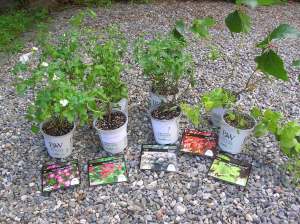 Here in Mid-Coast Maine the daylilies are poised for a big display of flower power. Though each of those glorious blooms only lasts a day — what color, what form and what beauty — daylilies are one of summer’s standards in the sunny garden. As much as we enjoy just looking at them, apparently there’s even more to like about daylilies — they taste good.
Here in Mid-Coast Maine the daylilies are poised for a big display of flower power. Though each of those glorious blooms only lasts a day — what color, what form and what beauty — daylilies are one of summer’s standards in the sunny garden. As much as we enjoy just looking at them, apparently there’s even more to like about daylilies — they taste good.
And because the blooms are with us for just a day, we won’t mind dedicating a few to dishes like these that come from Maria Zampini’s delightful e-newsletter “Upshoot.” She informs us that daylilies, like Pocket Full of Gold (above left), are edible and gives us a couple ways to prove that.
Here’s one way she suggests to try them:
Remove the stamens, rinse, dry and fry whole or strips after coating in a batter mix like Whistle Stop.
Include cleaned petals and chopped tender parts of stems and tubers in to salads.
Going further down the daylily culinary route, she offers a special beverage made with — what else? — daylilies!
Hemerocallis Coolers
Stay cool during dog days of summer with this infused drink:
Ingredients 12 daylilies (remove stamens)
½ cup sugar
2 cups spring water
7-UP
Apricot & Orange juice
Directions Make an infusion using 6 daylilies, ½ cup sugar, 2 cups of spring water. Bring to a boil. and simmer. Reduce by 1/3. Strain liquid and chill. Mix infusion equally with 1 part apricot juice, 1 part orange juice and 1 part 7-Up.
Pour over remaining daylilies, serve with ice. Garnish with borage and monarda flowers.
Tip – Eat daylilies in moderation, they can have a diuretic effect.
For more from Maria Zampini, visit the “Upshoot” website at: www.upshoothort.com
 Just out of the box, and ready to hit the ground running is a sampling of Proven Winners new shrubs and vines that arrived yesterday. There are some selections in this enticing mix we might not have thought about before — like Summer Shandy, an unusual climber with golden-yellow, finely-cut foliage. This frothy little number is actually a perennial hop.
Just out of the box, and ready to hit the ground running is a sampling of Proven Winners new shrubs and vines that arrived yesterday. There are some selections in this enticing mix we might not have thought about before — like Summer Shandy, an unusual climber with golden-yellow, finely-cut foliage. This frothy little number is actually a perennial hop.